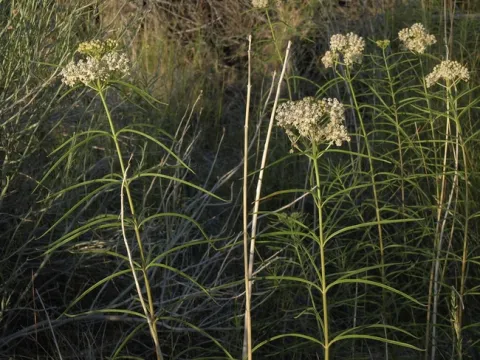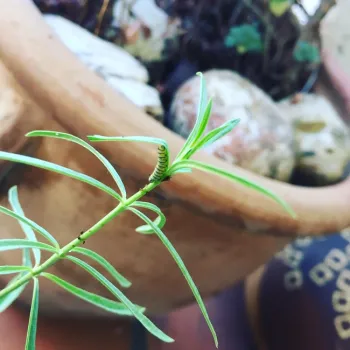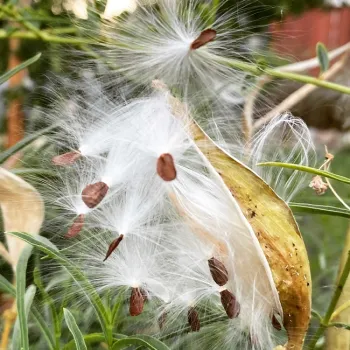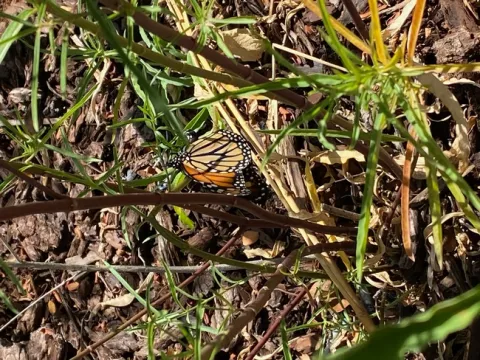
What is California's native milkweed and why should we plant it?
Native milkweeds are perennials with clusters of small (usually white or pink) flowers that grow in every eco-region of California. The native milkweeds are an important nectar source to a range of pollinators including bees, hummingbirds and butterflies. Native milkweeds go dormant during the winter and sprout anew during the spring.
Milkweed is especially well known for its importance to monarch butterflies, since they are the required host plant formonarch caterpillars. No milkweed means no monarchs. Land development and use of herbicides have dramatically reduced the presence of native milkweed by taking away the flatlands and meadow areas where the plant grows well. The monarch butterfly population has dramatically declined and the best way that gardeners can support the monarchs is by planting their necessary host plant - the milkweed - as well as other needed nectar plants and by avoiding the use of pesticides.

The Xerces Society lists 15 different native milkweeds to California but recommends that Narrowleaf Milkweed (Asclepias fascicularis) and Showy Milkweed (Asclepias speciosa) as the best species to plant due to their ability to grow in the widest range of conditions and the opportunity to buy them commercially.
Is native milkweed hard to grow?
Antonio Sanchez of the Rancho Sierra Vista native plant nursery says, “Of all the native milkweed species, Narrowleaf Milkweed is the easiest to grow. It is true that it is a little more difficult to grow than the very easy and showy tropical milkweed, but not by much. It is like the difference between growing spinach and watermelon, you just have to know where and when to plant it. If growing from seed, always start the seed in the warm months, from April to July. If
growing from live plants, always install from March-August. Water deeply and frequently the first year, once or twice a week. After the first year, plants normally thrive on twice a month waterings. Plants thrive in full sun, but tolerate part shade as well, and can be successfully grown in sandy or clay soils.”
Where can I buy it?
Unfortunately, buying native milkweeds is not as easy as a visit to your local outside box store. Many only sell tropical milkweed. You could certainly request it though! Ventura County has even taken the unprecedented step of banning the sale of tropical milkweed.
Most native plant nurseries and many independent nurseries will have narrowleaf milkweed for sale during its prime growing season, from March to August. You can search on the California Native Plant Society website Calscape.org to find nurseries in your area that carry one of the native milkweed species.
If I have tropical milkweed planted, what do you recommend?

Most experts agree that if you have tropical milkweed planted, you should cut it down to the ground as winter approaches in order to mimic the growth patterns of native milkweeds and allow a healthier regeneration of the plant in the Spring.
The controversy over tropical vs. native milkweed stays strong in some gardening circles but native plant nursery manager Antonio Sanchez recommends the following, “If you have tropical milkweed in your garden, keep it going as you get your native milkweed patch established. The first year, cut back your tropical milkweed to the ground around Thanksgiving, and to the ground again around Valentine's Day. After one or 2 years, your native milkweed patch should become established, and you can then completely remove your tropical milkweed plants.”
What are the Los Angeles Master Gardeners doing to support the monarchs?
Los Angeles UC Master Gardener Martin Saiz collaborated with the native plant nursery at Rancho Sierra Vista to successfully request a major grant from the National Fish and Wildlife Fund (NFWF). The purpose of the grant is to address population declines and ensure the survival of the monarch butterfly. Over the next two years, the grant will fund gathering native milkweed seed from across the Santa Monica Mountains, propagating thousands of milkweed plants at the nursery, planting milkweed in 150 nearby acres, and establishing a network of milkweed way stations in 300 community, school, senior, and shelter gardens across Los Angeles County.


